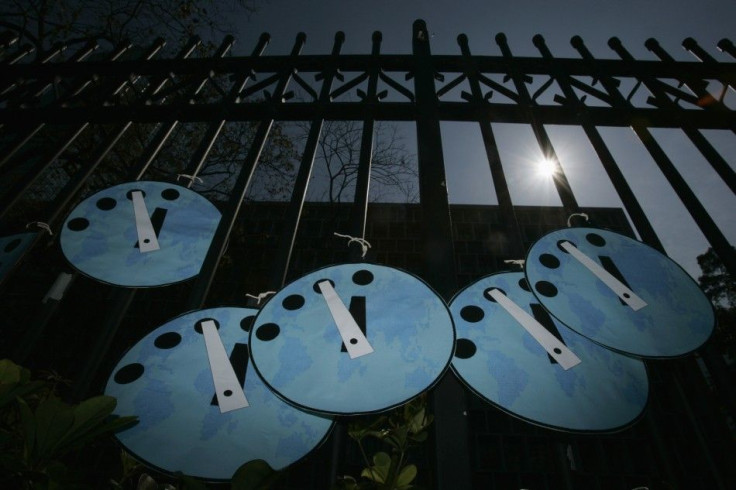'Doomsday Clock' Moves Closer to World Destruction

The hands of a symbolic doomsday clock fell back one minute Tuesday to five minutes to midnight, according to the Bulletin of the Atomic Scientists, which monitors global threats such as climate change, nuclear proliferation and human-caused disasters.
Two years ago, it appeared that world leaders might address the truly global threats that we face. In many cases, that trend has not continued or been reversed, the group announced on its Web site.
The move brought the world back to a symbolic edge of destruction last seen in 2007.
Several factors pushed the clock forwards: nuclear proliferation, climate change and fallout from the Fukushima nuclear plant disaster.
We're trying to weigh whether that was a wake-up call, whether it will make people take a closer look at this new and very powerful technology, or whether people will go on with business as usual, Bulletin director Kennette Benedict told LiveScience before the announcement in Washington, D.C.
Since 2007, Russia and the U.S. ratified the New START treaty in December 2010, which improved the nuclear disarmament picture. However, the recent failures in the Comprehensive Test Ban Treaty and treaties to cut production by leaders in the United States, China, Iran, India, Pakistan, Egypt, Israel, and North Korea set back the movement.
The world still has approximately over 20,000 deployed nuclear weapons with enough power to destroy the world's inhabitants many times over, Lawrence Krauss, an Arizona State University professor and the co-chair of the Bulletin's board of sponsors, told Fox News. We also have the prospect of nuclear weapons being used by terrorist non-state actors.
The Fukushima nuclear plant disaster, a result of the March 11 tsunami in Japan, also influenced the decision to turn ahead the doomsday clock.
Climate change became the biggest topic under review.
The global community may be near a point of no return in efforts to prevent catastrophe from changes in Earth's atmosphere, came the blunt assessment. The International Energy Agency projects that, unless societies begin building alternatives to carbon-emitting energy technologies over the next five years, the world is doomed to a warmer climate, harsher weather, droughts, famine, water scarcity, rising sea levels, loss of island nations and increasing ocean acidification.
The group said that alternatives to carbon and nuclear energy sources showed promise as prices drop for solar and energy conservation is becoming more accepted and widely adopted.
The doomsday clock came into being in 1947, two years after the nuclear bombing of Hiroshima and Nagasaki.
The clock came closest to midnight - symbolically doomsday - in 1953 after the first U.S. test of the hydrogen bomb drove the time to two minutes to midnight.
In its announcement Monday, the group suggested the minimum as a way to stave off disaster:
Ratification by the United States and China of the Comprehensive Test Ban Treaty and progress on a Fissile Material Cutoff Treaty;
Implementing multinational management of the civilian nuclear energy fuel cycle with strict standards for safety, security, and nonproliferation of nuclear weapons, including eliminating reprocessing for plutonium separation;
Strengthening the International Atomic Energy Agency's capacity to oversee nuclear materials, technology development, and its transfer;
Adopting and fulfilling climate change agreements to reduce carbon dioxide emissions through tax incentives, harmonized domestic regulation and practice;
Transforming the coal power sector of the world economy to retire older plants and to require in new plants the capture and storage of the CO2 they produce;
Vastly increasing public and private investments in alternatives to carbon emitting energy sources, such as solar and wind, and in technologies for energy storage, and sharing the results worldwide.
© Copyright IBTimes 2024. All rights reserved.











